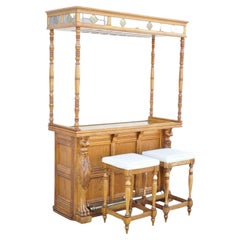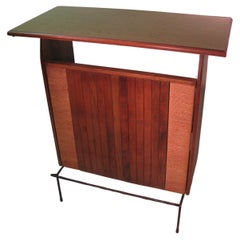Keepsake Pulaski Vintage Furniture
Mid-20th Century American Empire Keepsake Pulaski Vintage Furniture
Brass
People Also Browsed
21st Century and Contemporary Unknown Art Deco Keepsake Pulaski Vintage Furniture
Marble
1950s American Mid-Century Modern Keepsake Pulaski Vintage Furniture
Iron
1960s Mexican Mid-Century Modern Keepsake Pulaski Vintage Furniture
Mahogany
Late 20th Century Spanish Keepsake Pulaski Vintage Furniture
Bamboo, Wood, Lacquer
A Close Look at empire Furniture
From 1804–15, Napoléon I reigned as the emperor of France, bringing the country into a new era of opulence after the fall of the monarchy and the tumultuous years of the French Revolution. He declared, “We must have very solid things, made to last 100 years.” Empire-style furniture followed suit, with imposing pieces constructed from mahogany and adorned with gilded ornaments. Expanding on the neoclassicism popularized in the previous century — such as in Louis XVI style — Empire style borrowed from the great civilizations of antiquity, from Egypt to Greece and Rome, to connect this nascent empire to the power of the past.
Napoléon I believed the production of fine furniture would reflect the stature of the republic, with his official architects Charles Percier and Pierre-François-Léonard Fontaine leading the way with their work on his residences.
Luxurious materials, symmetrical shapes and bold colors characterize antique Empire-style bedroom furniture, armchairs, cabinets and other structures, with frequent motifs including mythological creatures, geometric designs, acanthus leaves, eagles, bees (the imperial emblem) and swans, a favorite of Empress Joséphine.
Flat surfaces, like marble tabletops, were accented with decadent details, such as the bronze furniture mounts made by sculptor Pierre-Philippe Thomire for the French palaces. Martin-Guillaume Biennais, who worked as the imperial goldsmith, crafted intricate luxury objects that mixed wood, fine metal, mother-of-pearl and ivory. Ormolu — or elaborate bronze gilding — was essential to French design in the 18th and 19th centuries as a cornerstone of the neoclassical and Empire styles.
The style became popular abroad, influencing the American Empire style. Stately pieces carved with sprigs of olives by cabinetmaker Pierre-Antoine Bellange were acquired by American President James Monroe for the White House in 1817.
Find a collection of antique Empire tables, lighting, seating and other furniture on 1stDibs.
Materials: brass Furniture
Whether burnished or lacquered, antique, new and vintage brass furniture can elevate a room.
From traditional spaces that use brass as an accent — by way of brass dining chairs or brass pendant lights — to contemporary rooms that embrace bold brass decor, there are many ways to incorporate the golden-hued metal.
“I find mixed metals to be a very updated approach, as opposed to the old days, when it was all shiny brass of dulled-out silver tones,” says interior designer Drew McGukin. “I especially love working with brass and blackened steel for added warmth and tonality. To me, aged brass is complementary across many design styles and can trend contemporary or traditional when pushed either way.”
He proves his point in a San Francisco entryway, where a Lindsey Adelman light fixture hangs above a limited-edition table and stools by Kelly Wearstler — also an enthusiast of juxtapositions — all providing bronze accents. The walls were hand-painted by artist Caroline Lizarraga and the ombré stair runner is by DMc.
West Coast designer Catherine Kwong chose a sleek brass and lacquered-parchment credenza by Scala Luxury to fit this San Francisco apartment. “The design of this sideboard is reminiscent of work by French modernist Jean Prouvé. The brass font imbues the space with warmth and the round ‘portholes’ provide an arresting geometric element.”
Find antique, new and vintage brass tables, case pieces and other furnishings now on 1stDibs.
Finding the Right dry-bars for You
The name “dry bar” can be a bit of a misnomer. After all, the last thing you would want a bar to do is run dry. In this case, the “dry” descriptor in your antique or vintage dry bar doesn’t refer to a lack of drinks. Instead, it serves to differentiate dry-bar furniture from wet-bar installations. The latter is typically a permanent fixture in a home, requiring plumbing to support a built-in sink.
In short, a dry bar is a piece of furniture or tabletop area that you’ve built into your space for mixing cocktails and storing everything needed —bottles, barware and other accessories — for the intoxicating in-home bar you’ve designed.
Some dry bars were built with minimalism in mind. Those crafted by designers associated with mid-century modernism or Scandinvanian modern, for example, likely looked to these as practical furnishings to serve as a cabinet or case piece. But there have been decorative and even outwardly sculptural interpretations by Art Deco furniture makers and those working in the Hollywood Regency style over the years.
No matter what kind of antique, new or vintage dry bar fits your space, these versatile furnishings can definitely elevate your home bar area as well as your hosting. We’ll toast to that!
Find your dry bar as well as all the barware you need on 1stDibs.


